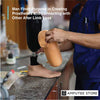The Forces That Influence Prosthetic Research
Adapting to amputee life takes time. This article takes you through some prosthetic projects at the Harvard Medical School (HMS) and how researchers tailor-fit technology to address prosthetic users' varied needs.

Moving the needle
The departments of Veteran Affairs and Defense support a big chunk of prosthetics research in the U.S. This is driven by the increase in the number of U.S. military amputees returning from Afghanistan and Iraq with rare injuries.
Through their funding and support, scientists are engineering prosthetic limbs that act more like biological ones. The medical community is also improving surgical methods that offer unprecedented prosthetic limb control as well as sensory feedback.
Their work will benefit veterans and about two million Americans experiencing limb loss because of cancer, congenital conditions, trauma, and vascular diseases like diabetes. This news makes the future of those who are coping with limb loss brighter.
A change in perspective
Besides working on prosthetic advancements, researchers emphasize the importance of shifting society's perspective on amputation. Historically, amputations are viewed as a medical failure. However, it needs to be seen for what it is: a form of limb salvage.
In an interview for Harvard Medicine's online magazine, Matthew Carty, HMS associate professor of surgery at Women's Hospital and Brigham, said that amputation might be a more effective way to better function and life. This shift in perspective is vital in ensuring good prosthetic outcomes.
The good news is that, in recent years, there's a gradual but palpable shift in how society understands limb loss, especially the role of technology in improving quality of life. This is crucial to help patients understand that limb loss is not the end, but rather the beginning.
Mimicking nature
More prosthetic researchers are looking to the body's natural biomechanics to improve efficiency and alleviate some of the possible health complications amputees may develop. These complications range from infection of the residual limb and muscle atrophy to cardiovascular conditions from inactivity and lower back pain due to unnatural movement.
For example, the usage of flexible materials, like carbon fiber, was due to the discovery that prosthetic users exert twice the effort to walk on a conventional prosthetic leg. Every step on a traditional prosthetic leg shocks the body, and energy is dissipated instead of reused. Prosthetic legs made from carbon fiber allow some of that energy to be reused.
One such prosthetic limb is the PowerFoot BiOM designed by Hugh Herr, director of the MIT Media Lab's Biomechatronics group and an HMS lecturer on rehabilitation and physical medicine at Spaulding. Herr also lost both of his legs below the knee to frostbite during a mountain climbing excursion in 1982.
Herr's Biomechatronics group collaborates with another research group to study energy expenditure and human movement. These studies will inform future prosthetic limb design. Furthermore, evidence of the health benefits from these advanced prosthetic limbs could extend access to them.
Cutting restricted access
Besides overcoming challenges in developing the best prosthetic technology, researchers are also making these prosthetic devices available to more people. Currently, there are too many insurance denials for advanced prosthetic limbs, as if wearing a prosthesis is a luxury.
For example, the current restrictions will allow only 15% of amputees in the U.S. access to a $75,000 computerized, battery-powered titanium prosthetic leg. The majority are covered by VA or workers' compensation policies.
In contrast, according to Amputee Coalition, there are about 54% of American amputees who lost their limbs to vascular diseases like diabetes. More often than not, amputees under this category—many of whom are in poor health and older—are not considered candidates for high-level prosthetic limbs.
Researchers are challenging this view by examining how to provide such patients with the best possible technology. With this undertaking, they hope that patients will be encouraged to move and exercise more, decreasing complications, like second amputations, which happen to about 60% of patients who lose a foot to diabetes. Should this program succeed, the researchers think that insurance companies might rethink their policies.
There may be hope as the U.S. Centers for Medicaid and Medicare Services recently created a reimbursement code for bionic prosthetic limbs.
Better surgical techniques
Throughout centuries, the surgical procedure for amputation has remained virtually the same. The standard technique often leads to painful growths and phantom limb pain, preventing patients from using sophisticated prosthetic limbs.
Researchers are currently developing an alternative surgical technique that preserves more of the residual limb's normal tissue relationships. This initiative began with below-knee amputations. The procedure is called AMI for agonist-antagonist myoneural interface.
As of publication, the procedure has been performed on six human patients with promising results. The patients reported less pain and more natural function when using conventional prosthetic limbs than patients with traditional amputations. Those who used advanced prosthetic limbs enjoyed a greater range of motion and more intuitive control.
AMI also restores proprioception, giving prosthetic users a sense of their limbs' position in space without looking. The team also hopes that AMI will reduce phantom limb pain.
Amputees with old or traumatic amputations may benefit from the AMI technique as a revision surgery. However, the surgical procedure can't be performed on patients with vascular diseases, such as diabetes.
Mind-controlled prosthetic limbs
Another initiative researchers are working on is linking prosthetic limbs to the brain. An example is BrainGate, a technology that aims to restore communication between the brain and prosthetic devices or muscles in patients with conditions like amyotrophic lateral sclerosis, spinal cord injury, and brain-stem stroke.
The technology is still in its early stages, with trials already underway. The team is also actively working toward a wireless iteration that will likely manifest as an implant.
Other developments
Although the bulk of prosthetic projects aim to improve devices and how they interact with the body, others seek to reduce the need for prosthetic limbs. HMS surgeons have administered successful single- and double-arm transplants, while stem cell scientists attempt to develop regenerative medicine to grow biological limbs one day.
These are just some of the prosthetic initiatives that are already underway. The goal of these projects is to improve the quality of life of prosthetic users. However, despite the advancements in prosthetic technology, more work needs to be done to improve access to these technologies.










































































